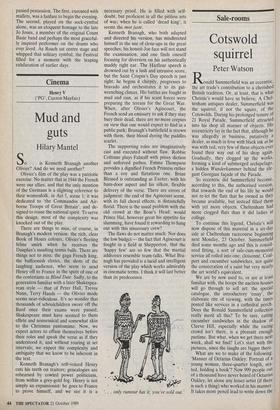Sale-rooms
Cotswold squirrel
Peter Watson
Ronald Summerfield was an eccentric, the art trade's contribution to a cherished British tradition. Or, at least, that is what Christie's would have us believe. A Chel- tenham antiques dealer, Summerfield was the squirrel, if not the squire, of the Cotswolds. During his prolonged tenure of 21 Royal Parade, Summerfield attracted into his shop all manner of objects. His eccentricity lay in the fact that, although he was allegedly in business, putatively a dealer, as much in love with black ink as he was with red, very few of these objects ever found their way out of his shop again- Gradually, they clogged up the works, forming a kind of submerged archipelago, a hidden Wunderkammer behind the ele- gant Georgian façade of the Parade.
So eccentric did Summerfield become, according to this, the authorised version, that towards the end of his life he would not re-let the flats that he owned as they became available, but instead filled them with yet more objects. Cheltenham had more clogged flats than it did ladies at college. To continue this legend, Christie's will now dispose of this material in a six-day sale at Cheltenham racecourse beginning next Monday, 23 October. Summerfield died some months ago and this is consid- ered fitting, a sort of sale-cum-memorial service all rolled into one: cloisonné, Coal- port and cucumber sandwiches, not quite the consecration of a saint but very nearly the art world's equivalent. We are by now used to, or are at least familiar with, the hoops the auction houses will go through to sell art: the special catalogue, the introductory 'essay', the elaborate rite of viewing, with the times posted like services in a cathedral porch. Does the Ronald Summerfield collection really merit all this? To be sure, eating cucumber sandwiches in the shadow of Cleeve Hill, especially while the racing crowd isn't there, is a pleasant enough pastime. But what, when we get there next week, shall we find? Let's start with the pictures, since the laughs are bigger there.
What are we to make of the following: 'Manner of Octarius Oakley: Portrait of a young woman, three-quarter length, sea- ted, holding a book'? Now 999 people out of a thousand have never heard of Octarius Oakley, let alone any lesser artist (if there is such a thing) who worked in his manner. It takes more pencil lead to write down the newfangled title than it did to draw the original portrait. Here we have a cunning catalogue entry which tries to persuade us that Octarius Oakley, whoever he may have been, was worthy of being imitated why else would someone do it? The plain truth is: he wasn't. It's an awful work, worse than awful.
Yet this catalogue is choked with tedious attributions to nobodies, a sort of art equivalent of those football commentaries on third division teams where you are never going to hear of the goal-scorer again: 'Circle of Frederick Tophan', 'Attri- buted to Valentine Bartholomew', `Fol- lower of Paul Poole', as if any of this was worth writing down. Another picture, described as 'English school', has a title running to 20 words but is in fact no more than a portrait of a child with a distinct resemblance to Harpo Marx, including the grey hair. Yet another, from the 'Circle of Carel von Falens' (oh, him!), is called 'Elegant Horseman Passing a Gypsy Family', yet looks for all the world like the opening scene from that Monty Python film where the peasants are shovelling shit. And lot 6942, William Bell Scott's picture of Proserpine, appears to show the lady after she has just stepped out of the Olympus Arms, or a similar hostel- ry, and is considering covering the classical landscape with whatever equivalent of Castlemaine XXXX the gods enjoyed. Her nose is as bilious as bratwurst.
But it isn't only the pictures. There is a pair of pink stockings which 'allegedly' belonged to Queen Victoria but may just as easily have belonged to Polly Pitville, the Cheltenham char. There are six horseshoes from 'winning racehorses' (an evening meeting at Wolverhampton?), and lot 6127 is 'A Japanese ivory and wood okimono of a seated monkey crying out as a wasp stings him on the right shoulder, Persimmon spray in his left hand, the eyes inset in mother-of-pearl'. That persimmon spray is a bit iffy but even without it the object might just see service as a blunt instrument for anyone contemplating GBH. Damage could only improve its appearance.
What is all this? Summerfield's fans will no doubt argue that he collected some decent china and passable silver. Why not sell just that? Most of this 'collection' never was a word more inappropriate — is as beautiful as a 200-point drop in the stock market. Worse, it is not even kitsch, which at least has shock value if not aesthetic Merit.
It is hard to spoil the promise of a few autumn days out in Royal Glos. But, going through the Summerfield stuff again and again, one has the sneaking impression (perhaps not so sneaking) that his eccen- tricity may well have been apocryphal, and that the real reason all those rooms in Cheltenham silted up with his objects was because, quite simply, no one else would pay ready money for such detritus.



























































 Previous page
Previous page